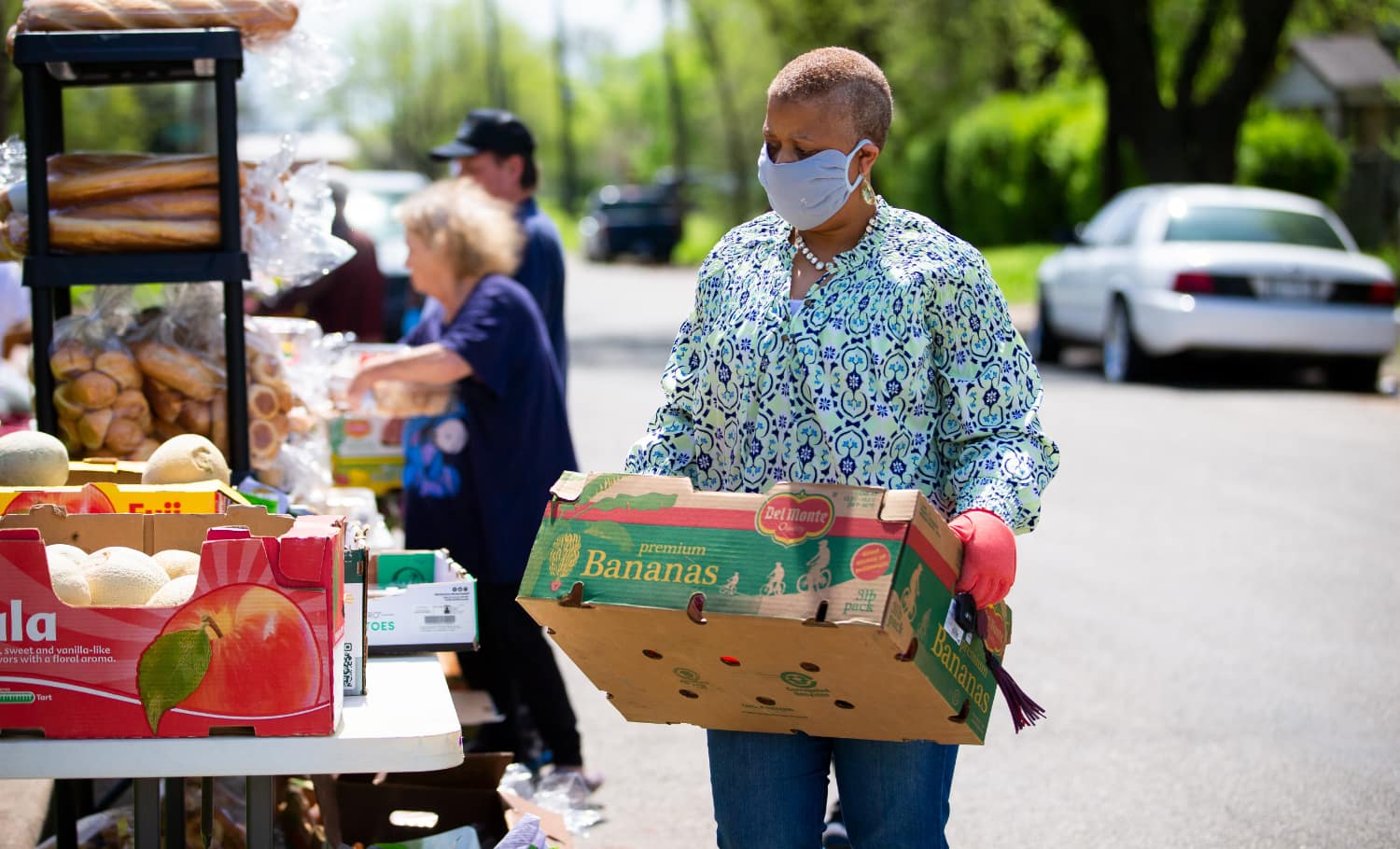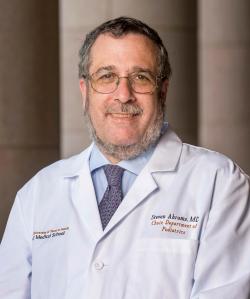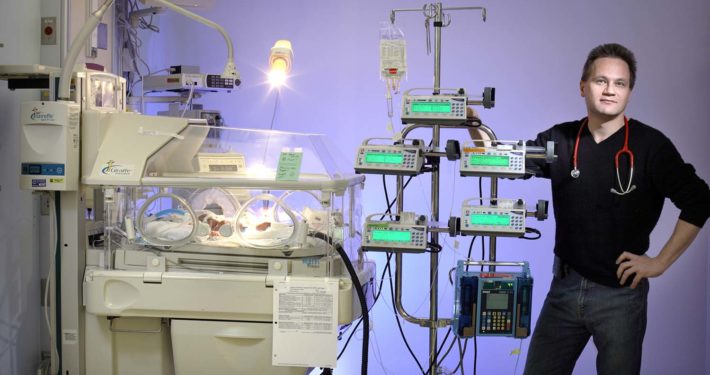Cracks in the System: Child Food Insecurity and COVID-19
Dr. Steven Abrams, Chair of the AAP Committee on Nutrition, discusses the lessons from the COVID-19 pandemic on how the U.S. is failing food insecure families, and how we can do better.
Proper nutrition and food security are essential to the healthy development of a child—physically, emotionally, and psychologically. Dr. Steven Abrams, Chair of the AAP Committee on Nutrition, discusses how pediatricians can improve their screening for and treatment of food insecurity. He also explains the relationship between COVID-19 and food insecurity, and explores how the U.S. can better support its most vulnerable populations.
Nutrition and Food Equity
The COVID-19 pandemic has exposed a host of underlying inequities in the United States. Among them is food insecurity, one of the myriad issues disproportionately impacting low-income Americans. As COVID-19 has decimated jobs, it has also disrupted the systems that feed underemployed families and children. Millions of families have lost work, creating long lines at food banks and even longer waits to secure unemployment insurance, which could include SNAP benefits or other supplemental food assistance.
Feeding America defines food insecurity as a household’s inability to afford sufficient quality food “for every person to live an active, healthy life.” Food insecurity is associated with higher rates of hospitalization for infants and toddlers; impaired academic and social skills and asthma in young children; and anemia and lower bone-density in adolescents.1 Dr. Steven Abrams, M.D., Chair of the AAP Committee on Nutrition (CON), sheds light on the underlying causes of food insecurity and poor nutrition in American children, and how pediatricians can better support families in need. Further, he discusses the cracks that COVID-19 has exposed in our federal food assistance programs. Dr. Abrams sees poverty, access to pediatric care, and food insecurity are fundamentally intertwined. Tending to one of these issues requires considerations of all three.
“As I’ve returned to research I’ve become even more interested in social justice related to food, and recognized that we have some major problems in the U.S.”Dr. Steven Abrams
The Ups and Downs of Food Assistance Programs
Alongside his work with the AAP, Dr. Abrams is also a professor of pediatrics at University of Texas at Austin. Specializing as a neonatologist, Dr. Abrams has developed and championed the use of stable isotopes to determine mineral requirements and physiological turnover rates in infants and children. He spent 20 years researching global malnutrition in over 30 countries, looking particularly at micronutrients. Today, his focus is on research and policy in the U.S.
“The Committee on Nutrition works very closely with AAP federal affairs,” Dr. Abrams explains. “We are both a policy group and an advocacy group providing the science behind legislation.” He describes his current projects as focused on combating inequality in the U.S.: “As I’ve returned to research, I’ve become even more interested in social justice related to food, and recognized that we have some major problems in the U.S.”
These problems do not necessarily lie with our food support programs themselves, Dr. Abrams posits, but rather in implementation and utilization. “The U.S. has a fairly extensive safety net for food through WIC, SNAP, school lunches, et cetera.” Abrams says. “It’s not fair to say we don’t have effective food support programs. But we have issues with access.”
He offers the Special Supplemental Nutrition Program for Women, Infants, and Children (WIC) as an example. “We know that only 80% of families with infants who are eligible for WIC participate, and even fewer with children 1 to 5 years of ageDr. Abrams says. “We want that number to be 100%. Some reasons include issues of legal access. Even though WIC does not ask about immigration status, undocumented families are concerned about participating in government programs,— for good reason.” Dr. Abrams explains that participating in these programs can also be logistically difficult for low-income parents. “To go to a WIC clinic, families might have to take multiple bus trips or take time off work,” says Abrams. “For low-income people this is often not feasible. The programs themselves are fairly robust, but we haven’t made it very easy for families to utilize them.”
Federal food support programs are supplemental, meaning they do not cover a family’s entire month of food. The Supplemental Nutrition Assistance Program (SNAP) is by definition intended to supplement a family’s income, just like WIC. “WIC can meet about 80% of an infant’s formula needs, but that 20% gap can be a very big gap if you’re low income,” says Dr. Abrams. “It’s not a complete food system.”
“Worry about running out of food is much more prevalent and causes high levels of stress, which affects children emotionally and psychologically. Pediatricians need to start by asking families the simple question: are you ever worried about running out of food?”Dr. Steven Abrams
Who Experiences Food Insecurity?
As of 2020, the federal poverty threshold was $26,200 for a family of four, according to the U.S. Department of Health and Human Services. A 2017 Feeding America report found that “nearly 40 million people in the U.S. earned incomes less than the poverty line. In addition… nearly 1 in 8 live in households with limited access to adequate food during the year due to lack of money and other resources.” The Children’s Defense Fund found that in 2020, 1 in 6 children (nearly 12 million) in America live in poverty, making them the poorest age group in the country.
Just as certain identity groups are more likely to experience poverty in the U.S., they are also more likely to experience food insecurity. “Latinx, African American, and immigrant families experience higher rates of food insecurity than White families,” says Dr. Abrams. Feeding America reports that, “although half of food-insecure households are White, they represent 1 in 11 White households in the U.S. compared to nearly 1 in 5 African American and 1 in 6 Latinx households who are food insecure.”2
In the State of America’s Children 2020 report, the Children’s Defense Fund noted that, “Children’s physical health and brain development depend on them being well-fed, particularly in the earliest years of life. Hunger and malnutrition jeopardize children’s health, development, education and career readiness.”
Dr. Abrams agrees. “Food insecurity causes physical, emotional and psychological problems for children, and can be included in the list of Adverse Childhood Experiences [ACEs] that impact a child’s development. Kids are very sensitive to family food insecurity.”
It can be helpful for pediatricians to distinguish between food shortage and food stress, Dr. Abrams adds. “We’ve found that about 5-10% of families actually run out of food over the course of a month,” he explains. “But the worry about running out of food is much more prevalent and causes high levels of stress, which affects children emotionally and psychologically. Pediatricians need to start with the simple question: are you ever worried about running out of food?”
Dr. Abrams says treating children’s worry and stress is just as important as making sure they get fed. ACEs researchers found that continued exposure to toxic stress, which can begin before birth, has serious consequences for brain development. Toxic stress impairs the brain’s ability to regulate emotions, and the stage that precedes regulation: emotion identification.3 Children experiencing toxic stress may be unable to name their emotions or self-soothe as adults.4
Pediatricians should also be on the lookout for food insecurity among college students, according to Abrams. “At UT Austin, the rate of food insecurity among college students is 15%,” he says. “And we’re seeing higher numbers at other large public universities. Food insecurity on campuses can be hard to identify, so pediatricians should be screening for it if possible.” A study at University of California (UC) found that 39% of UC students had low or very low food security. Food-insecure students reported a lower GPA and more financial hardship than their food-secure peers.5
EHRs and Children’s Nutrition
In helping to combat childhood food insecurity, pediatricians also face a lack of connection between government food support programs and patients’ health records. When a pediatrician looks at a patient’s record, they won’t necessarily know if that family participates in SNAP, WIC, or other food support programs—and families don’t always volunteer that information without prompting.
“There’s no EHR connection between the WIC clinic and the pediatrician’s office,” says Dr. Abrams. “If the WIC clinic screens for anemia, they hand the parents a piece of paper that says what the baby’s hemoglobin is and tell them to go to the doctor. This process leaves a lot of room for human error.”
Abrams says the reasoning behind this systemic inefficiency is foggy. “We’ve talked about this numerous times on Capitol Hill,” says Dr. Abrams. “The reality is that there isn’t an effective electronic system developed that links federal programs and doctors. Some folks cite HIPAA, but I don’t find that argument compelling.”
While a formal connection between EHR and WIC does not yet exist, pediatricians can gather crucial demographic data by inquiring about WIC and similar programs with every patient. Data could be collected via a form, for example, and stored in the EHR for referencing individual patients or population health.
Motherhood, Policy, and the First 1,000 Days
In the U.S., food insecurity is more common than malnutrition, but Dr. Abrams advises that providers screen for both. “Malnutrition is relatively uncommon in the U.S., but it certainly exists here,” he says. “At the CON, we talk a lot about the first 1,000 days of life. There’s a window from conception to a child’s second birthday where their developmental trajectory is set. A child who is severely anemic at two years old is likely going to have consequences for a lifetime. This is a big theme in global health, but we need to understand it in the U.S. as well.
To ensure healthy development through the first 1,000 days, both policies and providers must support low-income mothers, who comprise a particularly vulnerable group when it comes to food insecurity. For single mothers, the chances of food insecurity and malnutrition are even higher. Households with children led by single women experience food insecurity at 2.5 times the average household rate.6 What might this vulnerability look like in practical terms? “Malnutrition can happen when families dilute their baby formula to make it last longer,” Dr. Abrams explains. “Data suggests that 15-20% of families over-diluted formula, which can negatively affect the brain development of their baby.”
Dr. Abrams points to the U.S.’s dismal family leave policies as contributing to infant malnutrition. Pew Research Center reports that the U.S. is one of the only wealthy nations in the world without federally mandated paid family leave, which reverts family leave policies to the discretion of individual employers. “In the U.S. about 80% of mothers go home from the hospital breastfeeding,” says Dr. Abrams. “The main problem isn’t convincing moms to breastfeed, it’s making it feasible for them to continue breastfeeding after they go back to work.”
Abrams continues, “From a social justice and policy perspective, our efforts must be directed towards extending time off after giving birth and providing support for working mothers. As of now, all 50 states have laws in place to protect breastfeeding in public, although that doesn’t mean it’s socially acceptable everywhere or that women from a variety of cultures feel comfortable, so we also need to support women with formula.”The various, contradictory stigmas around motherhood in the U.S. make working, breastfeeding, and mothering all the more challenging for new moms. Dr. Abrams believes that pediatricians can help alleviate these stressors by practicing non-judgment: “While we know the benefits of breastfeeding, we never shame or criticize formula feeding moms— it’s not productive,” Dr. Abrams says. “People are making choices based on their life circumstances. Mothers know what they need to do for their own bodies and their baby’s.”
“COVID-19 exposed a lot of weaknesses in our food delivery systems, all of which affect poor families more than families of means.”Dr. Steven Abrams
COVID-19 Creating Greater Food Stress
During the first months of the COVID-19 pandemic, SNAP participation jumped by 15% nationally, according to Politico. Families with children home from school could no longer rely on school lunch programs and needed additional support; unemployed folks couldn’t make ends meet. As a second Coronavirus relief bill made its way through Congress, advocates argued for an extension of SNAP benefits.
“One measure advocates were pushing for in the COVID recovery bill was an increase in SNAP benefits, but that didn’t go through this time,” regrets Abrams. “But we’ll keep pushing for it.” He highlights the importance of government support of children’s nutrition during this unprecedented moment in history: “Federal programs, such as school lunches, simply aren’t prepared for this kind of a crisis,” says Abrams. “COVID-19 exposed a lot of weaknesses in our food delivery systems, all of which affect poor families more than families of means.”
What does this inequality look like? “For example, a family that can afford it could always go online and order baby formula to be shipped to them,” says Abrams. “A family that’s on WIC can’t order online, and there are formula shortages at grocery stores, so the poor family loses out.”
Dr. Abrams and his colleagues recently published a study in the Journal of Pediatrics that found that 94% of food insecure families indicated their food insecurity had begun or worsened during the pandemic. Of the 115 families volunteering information about employment, 46% reported job loss during the pandemic. The study further highlights racial inequalities exposed by the pandemic; among Hispanic families, those who spoke only Spanish (as opposed to English and Spanish) were far more likely to experience food insecurity.7 Crucially, this information was gathered during family visits to their pediatricians. “Again, it’s so important for pediatricians to be asking parents and children about hunger, food, and worry about food running out,” says Dr. Abrams.
In addition to advocating for the expansion of WIC and SNAP during the crisis, AAP federal advocacy has other important objectives. “Categorical eligibility—which means if you’re eligible for one federal program you’re potentially eligible for multiple without requiring separate enrolllment processes—is under threat right now. It’s the kind of thing where if 60% of kids in a school district are eligible for free lunch, then all the kids get free lunch,” explains Abrams. “We’re fighting for low income families during a time when so many of our country’s safety nets are being stripped away.”
One way pediatricians can join this fight is to serve as first responders to food insecurity. For additional information on how to support food insecure families, the AAP has developed the Addressing Food Insecurity Toolkit for Pediatricians. It includes resources on how to educate and train staff, screen for food insecurity in children and families, and address food insecurity with sensitivity and compassion. During the COVID-19 crisis, awareness of food insecurity is more important than ever for pediatricians, and screening and treating it with compassion will improve lives.
[1] Forman et. al. Food Insecurity and Hunger: Quiet Public Health Problems on Campus. Journal of Nutrition & Food Sciences. 2018 ↑
[2] https://hungerandhealth.feedingamerica.org/wp-content/uploads/2018/10/Food-Insecurity-Poverty-Brief_2018.pdf ↑
[3] Van der Kolk. Adverse Childhood Experiences and the Lifelong Consequences of Trauma. 1998 ↑
[4] Center on the Developing Child at Harvard University. Key concepts: toxic stress. 2014 ↑
[5] Forman et. al. Food Insecurity and Hunger: Quiet Public Health Problems on Campus. Journal of Nutrition & Food Sciences. 2018 ↑
[6] https://hungerandhealth.feedingamerica.org/wp-content/uploads/2018/10/Food-Insecurity-Poverty-Brief_2018.pdf ↑
[7] Abrams, Steven et. al. High Levels of Food Insecurity among Families with Children Seeking Routine Care at Federally Qualified Health Centers during the COVID-19 Pandemic. The Journal of Pediatrics. June 2020 ↑
Emily Graf is a freelance writer, wilderness educator, and English teacher living in Colorado. She is passionate about telling stories that promote equal access to quality health care. She can be contacted at emgraf11@gmail.com for inquiries.










